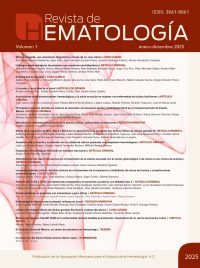Rev Hematol Mex. 2025; 1: 1-12. https://doi.org/10.24245/rev_hematol.v26i1.40
Lizbeth Grimaldo,1 Samantha Climaco Arvizu2
1 Secretaría de Ciencia, Humanidades, Tecnología e Innovación, Ciudad de México.
2 Unidad de Investigación en Enfermedades Oncológicas, Centro Médico Nacional Siglo XXI, IMSS, Ciudad de México.
Resumen
ANTECEDENTES: La velocidad de sedimentación globular es una prueba hematológica clásica utilizada como marcador inespecífico de inflamación. A pesar del desarrollo de biomarcadores más sensibles y específicos, como la proteína C reactiva, la interleucina 6, la procalcitonina y la calprotectina, la velocidad de sedimentación globular sigue usándose ampliamente, especialmente en contextos clínicos con acceso limitado a tecnologías más avanzadas.
OBJETIVO: Analizar la precisión diagnóstica y la utilidad clínica de la velocidad de sedimentación globular en comparación con biomarcadores inflamatorios modernos en enfermedades distintas a la polimialgia reumática y la arteritis temporal.
METODOLOGÍA: Revisión narrativa y sistemática conforme a los lineamientos PRISMA 2020. Se incluyeron estudios clínicos en adultos que comparan la velocidad de sedimentación globular con al menos uno de los biomarcadores modernos mencionados. La búsqueda se hizo en PubMed y Scopus entre 2010 y el 2025; se aplicaron criterios estrictos de inclusión y exclusión.
RESULTADOS: De 198 registros identificados, se seleccionaron 10 estudios relevantes. La velocidad de sedimentación globular mostró menor sensibilidad y especificidad en comparación con la proteína C reactiva, la interleucina 6, la procalcitonina y la calprotectina en la mayor parte de los escenarios clínicos. Sin embargo, su utilidad persiste en ciertos contextos, especialmente cuando supera umbrales específicos (más de 30 mm/h), en combinación con otros marcadores o en la evaluación inicial de pacientes sin acceso a pruebas modernas.
CONCLUSIÓN: La velocidad de sedimentación globular conserva valor diagnóstico como prueba complementaria de bajo costo. No debe interpretarse de forma aislada, sino integrada al juicio clínico, especialmente en regiones con recursos limitados.
PALABRAS CLAVE: Sedimentación sanguínea; inflamación; proteína C reactiva.
Abstract
BACKGROUND: Erythrocyte sedimentation rate is a classic hematological test used as a nonspecific marker of inflammation. Although newer biomarkers such as C-reactive protein, interleukin 6, procalcitonin, and calprotectin offer greater sensitivity and specificity, erythrocyte sedimentation rate remains widely utilized, particularly in settings with limited access to advanced laboratory diagnostics.
OBJECTIVE: To assess the diagnostic accuracy and clinical utility of erythrocyte sedimentation rate in comparison to modern inflammatory biomarkers in diseases other than polymyalgia rheumatica and temporal arteritis.
METHODOLOGY: A narrative and systematic review conducted in accordance with PRISMA 2020 guidelines. The review included clinical studies involving adults, retrieved from PubMed and Scopus databases (2010-2025), that directly compared erythrocyte sedimentation rate with at least one modern biomarker and reported sensitivity, specificity, or other relevant diagnostic metrics.
RESULTS: Out of the 198 publications initially screened, 10 studies fulfilled the eligibility criteria and were included in the qualitative synthesis. Overall, erythrocyte sedimentation rate demonstrated lower sensitivity and specificity compared to C-reactive protein, interleukin 6, procalcitonin and calprotectin in most clinical settings. Nonetheless, erythrocyte sedimentation rate retained clinical value in specific contexts, particularly when used in combination with other tests or in cases where values exceeded defined thresholds (e.g., > 30 mm/h).
CONCLUSION: Erythrocyte sedimentation rate remains a relevant, low-cost complementary test in inflammatory and infectious disease assessment. However, its interpretation must be integrated with clinical findings and other laboratory parameters, especially in resource-constrained environments where more specific biomarkers may be unavailable.
KEYWORDS: Erythrocyte sedimentation; Inflammation; C-reactive protein.
Recibido: 24 de febrero 2025
Aceptado: 18 de junio 2025
Este artículo debe citarse como: Grimaldo L, Climaco-Arvizu S. Velocidad de sedimentación globular en la práctica clínica: aplicaciones y limitaciones. Hematol Méx 2025; 1: 1-12.

